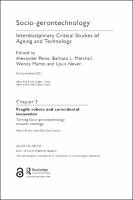Chapter 3 Fragile robots and coincidental innovation
Proposal review
Turning Socio-gerontechnology towards ontology
| dc.contributor.author | Ertner, Marie | |
| dc.contributor.author | Lassen, Aske Juul | |
| dc.date.accessioned | 2021-06-16T09:23:33Z | |
| dc.date.available | 2021-06-16T09:23:33Z | |
| dc.date.issued | 2021 | |
| dc.identifier.uri | https://library.oapen.org/handle/20.500.12657/49553 | |
| dc.description.abstract | Social change in the 21st century is shaped by both demographic changes associated with ageing societies and significant technological change and development. Outlining the basic principles of a new academic field, Socio-gerontechnology, this book explores common conceptual, theoretical and methodological ideas that become visible in the critical scholarship on ageing and technology at the intersection of Age Studies and Science and Technology Studies (STS). Comprised of 15 original chapters, three commentaries and an afterword, the book explores how ageing and technology are already interconnected and constantly being intertwined in Western societies. Topics addressed cover a broad variety of socio-material domains including care robots, the use of social media, ageing in place technologies, the performativity of user involvement and public consultations, dementia care and many others. Together, they provide a unique understanding of ageing and technology from a social sciences and humanities perspective and contribute to the development of new ontologies, methodologies and theories that might serve as both critique of, and inspiration for, policy and design. International in scope, including contributions from the UK, Canada, USA, Germany, Norway, Denmark, Austria, The Netherlands, Spain and Sweden, Socio-gerontechnology is an agenda-setting text that will provide an introduction for students and early career researchers as well as more established scholars that are interested in ageing and technology. | en_US |
| dc.language | English | en_US |
| dc.subject.classification | thema EDItEUR::J Society and Social Sciences::JH Sociology and anthropology::JHB Sociology | en_US |
| dc.subject.classification | thema EDItEUR::J Society and Social Sciences::JB Society and culture: general::JBF Social and ethical issues::JBFM Disability: social aspects | en_US |
| dc.subject.classification | thema EDItEUR::J Society and Social Sciences::JB Society and culture: general | en_US |
| dc.subject.classification | thema EDItEUR::J Society and Social Sciences::JM Psychology::JMC Child, developmental and lifespan psychology | en_US |
| dc.subject.other | socio-gerontechnology; Alexander Peine; Barbara Marshall; Wendy Martin; Louis Neven; ageing; technology; gerontology; digital technology; age studies; science and technology studies; STS; social media; neighbourhoods; ageing-in-place; co-housing; activism; dementia; public policy; later life; new materialism; technoscience; agency; participatory methods; ageism | en_US |
| dc.title | Chapter 3 Fragile robots and coincidental innovation | en_US |
| dc.title.alternative | Turning Socio-gerontechnology towards ontology | en_US |
| dc.type | chapter | |
| oapen.identifier.doi | 10.4324/9780429278266-3 | en_US |
| oapen.relation.isPublishedBy | 7b3c7b10-5b1e-40b3-860e-c6dd5197f0bb | en_US |
| oapen.relation.isPartOfBook | afa38384-1aca-44bb-97a6-9ca157650c8f | en_US |
| oapen.relation.isbn | 9780367230821 | en_US |
| oapen.relation.isbn | 9780367682125 | en_US |
| oapen.imprint | Routledge | en_US |
| oapen.pages | 14 | en_US |
| oapen.remark.public | The OA chapter is funded by IT University of Copenhagen, Denmark | |
| peerreview.anonymity | Single-anonymised | |
| peerreview.id | bc80075c-96cc-4740-a9f3-a234bc2598f1 | |
| peerreview.open.review | No | |
| peerreview.publish.responsibility | Publisher | |
| peerreview.review.stage | Pre-publication | |
| peerreview.review.type | Proposal | |
| peerreview.reviewer.type | Internal editor | |
| peerreview.reviewer.type | External peer reviewer | |
| peerreview.title | Proposal review | |
| oapen.review.comments | Taylor & Francis open access titles are reviewed as a minimum at proposal stage by at least two external peer reviewers and an internal editor (additional reviews may be sought and additional content reviewed as required). |

